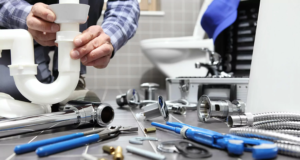A septic tank is a small underground chamber through which domestic wastewater (sewage) flows for basic sewage treatment. Solid waste and sediment settle and are digested by anaerobic bacteria, releasing liquid waste water (known as effluent). Contact Septic Tank Armadale now!
Septic tanks have inlet and outlet pipes which drain the pre-processed wastewater into the absorption field. They also have a riser and lid to allow for pumping and inspections without digging up your yard.

The inlet pipe allows wastewater to flow into your septic tank. It may be made of concrete, fiberglass, or plastic and is usually about 12 inches in diameter. It is placed at the inlet of your septic tank perhaps 6 inches below the top edge (top surface of the tank to the top of the inlet tee). The inlet tee blocks floating scum layer waste from flowing directly into the inlet sewer line; such an action could clog the system and redirect sewage back into your home.
As the wastewater flows through the inlet pipe, it enters the septic tank and separates into three layers: sludge, scum, and liquid effluent. Solids that are denser than water sink to the bottom, forming the sludge layer; lighter substances like hair and toilet paper rise to the top, forming the scum layer. The liquid in between, known as effluent, is a result of anaerobic digestion and is relatively clear.
During anaerobic digestion, the bacteria in the septic tank degrade the organic matter and reduce its volume. Sludge and scum must be removed from the tank periodically to prevent them from flowing directly into the absorption field and causing the system to fail.
Once the septic tank has separated the waste into its respective layers, it is treated by the soil in the absorption field. The absorption field is a network of perforated pipes buried in shallow, gravel-filled trenches. The effluent from your septic tank passes through the inlet pipe, then the inlet baffle, then the outlet pipe into the absorption field. The soil in the absorption field acts as a physical, chemical and biological filter to remove disease organisms from the effluent and make it suitable for groundwater.
The septic tank outlet pipe, typically made of PVC or ABS, carries the treated effluent from your septic system into the drain field. It may include a T-shaped outlet to prevent scum and solids from exiting the tank and clogging the absorption field. A six-inch diameter inspection pipe extends from the top of the tank to just above the outlet baffle; this allows septic tank service professionals to insert cameras into the tank to check for sludge and scum levels.
Outlet Pipe
The septic tank separates solid waste from liquid. Inside the septic tank, weighty masses sink to the bottom and form sludge, while oil and grease rise to the top and form a scum layer. The middle layer of clear liquid (effluent) exits the tank through the outlet pipe. Inside the septic tank, special compartments and baffles help to keep the sludge from exiting the septic tank with the wastewater.
The outlet pipe carries the treated sewage from your septic tank to the drain field, or leach field, a series of perforated pipes or trenches buried in the soil where natural processes further treat the sewage. Having a properly functioning and protected outlet pipe is critical to prevent the flow of solids and grease into the drain field, which could clog or damage the system and lead to costly repairs.
Whenever the septic tank is pumped, the inlet and outlet pipes should be cleaned out as well. A professional technician should also clean out the inspection tube, which is a small pipe on the top of the tank. This allows septic tank service companies to inspect the condition of your septic tank and your entire septic system.
If you suspect your septic tank may be leaking, make a map of your septic system and its access holes to locate the inlet and outlet pipes. Then probe the soil near the home’s foundation with a metal rod to find the septic tank, distribution box and absorption field. If you can’t find the location, call a professional.
The inlet and outlet tees in your septic tank are typically 2 or 3 inches deeper than the scum layer at the bottom of the septic tank. This keeps sludge and floating scum from entering the septic tank outlet and flowing out to your absorption field, where it would quickly clog the system and cause it to fail. If your septic tank inlet and/or outlet tees are missing these baffles, they should be replaced.
Drain Field
Your septic system’s drain field, also known as the leach field or absorption field, is an important part of your home wastewater treatment system. It filters and treats the effluent from your septic tank, ensuring that contaminants are removed before water is returned to the environment. Proper maintenance and inspections are key to a properly functioning septic drain field.
Wastewater from toilets (blackwater) and your sinks, tubs, showers, washing machines, and dishwashers (greywater) runs into a main drainage pipe that leads to the septic tank. The solid materials sink to the bottom of the tank to form a layer of sludge, while oils and greases float to the top to be broken down by bacteria. The liquid wastewater passes through a perforated pipe into the drain field where it seeps into and through the soil below.
Once in the drain field, the wastewater is filtered by the surrounding soil before it seeps into groundwater or natural watercourses. The septic system keeps human waste below ground and away from homes, preventing nutrient-rich wastewater runoff and disease-causing pathogens from polluting surface waters.
As a homeowner, it is important to take care of your septic system to prevent expensive and time-consuming repairs. Regularly inspect your septic tank, keep track of when it needs to be pumped, and never drive or park vehicles or equipment on the drain field. Heavy traffic and vehicle weight can compact the soil and impede the flow of wastewater, leading to failure or overflow.
Since septic system pipes are often located below ground, they are also vulnerable to damage from things happening above ground. Avoid building structures like sheds, decks, or patios over the drain field, and don’t plant trees or shrubs within ten feet of the pipes to reduce the risk of invasive root systems infiltrating and clogging the small perforations that allow wastewater to exit the system.
If you see signs that the septic system is having trouble, call in a professional to investigate. Unusually foul odors near the drain field, wet or soggy ground, and slow-draining kitchen and bathroom pipes are all common signs that something is wrong. A professional can use specialized tools and equipment to determine the source of the problem, which is most likely caused by a malfunctioning drain field.
Riser & Lid
A septic tank riser is a shaft that extends from the access ports in the top of your septic tank up to ground level. It’s a vital part of your septic system, as it makes accessing the septic tank for pumping, maintenance checks and inspections much easier. It’s a worthy investment that will save you money on septic tank service costs in the long run.
The access port on the septic tank is an opening in the lid that allows septic professionals to enter your septic tank and pump it out. A septic tank riser lifts the access port to ground level, eliminating the need to dig up your yard and saving you time and money.
When a liquid wastewater enters your septic tank, it flows to the inlet baffle. This design keeps surface scum from clogging the inlet pipe and reduces wastewater agitation. The baffle wall also separates your septic tank into compartments that allow solids to settle. This process helps ensure your clarified liquid wastewater exits the septic tank into your drain field with little to no solids.
As bacteria break down wastewater contaminants, they produce gases. These gases must be vented to prevent a buildup of pressure that could cause your septic tank to stop working properly. The gases are released through a vent pipe in your septic tank, which is often shaped like a mushroom and may be fitted with a charcoal filter to reduce odors.
Risers are available in concrete, polyethylene and fiberglass. The three materials differ in durability, ease of installation and cost. Concrete risers are the least expensive, but they’re difficult to install and prone to leaks. Polyethylene risers are easier to install and more durable than concrete, but they’re still vulnerable to leaking gasses. Fiberglass is an in-between option that’s durable and affordable.
A septic tank riser and lid make the entire process of having your septic tank pumped, maintained or inspected much faster and simpler for Clermont homeowners. If you’d like to avoid the hassle of digging up your lawn every time you need your septic tank emptied or inspected, Lentz Wastewater can install a riser and cover for your home.








